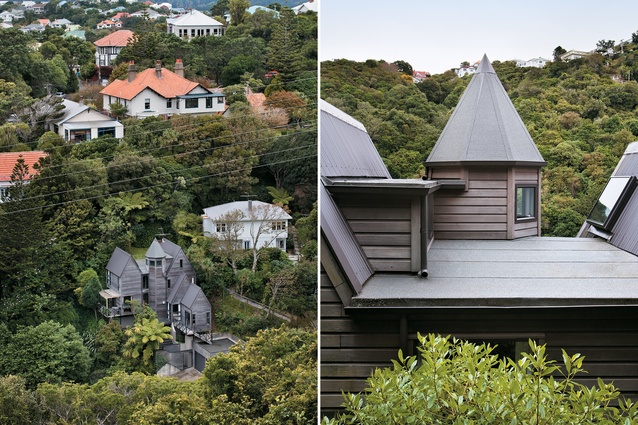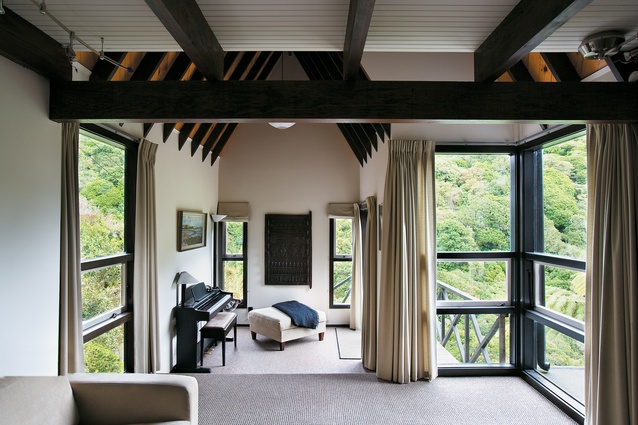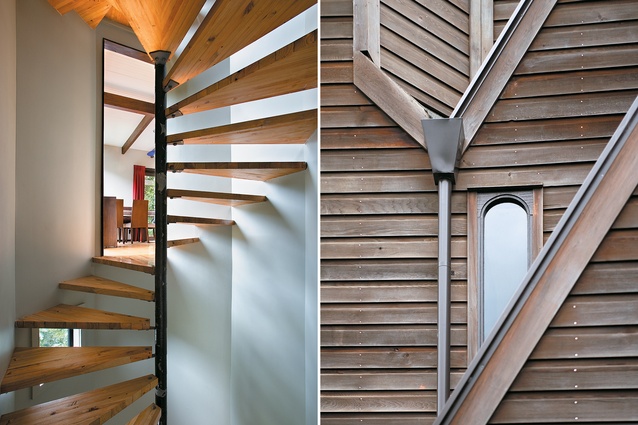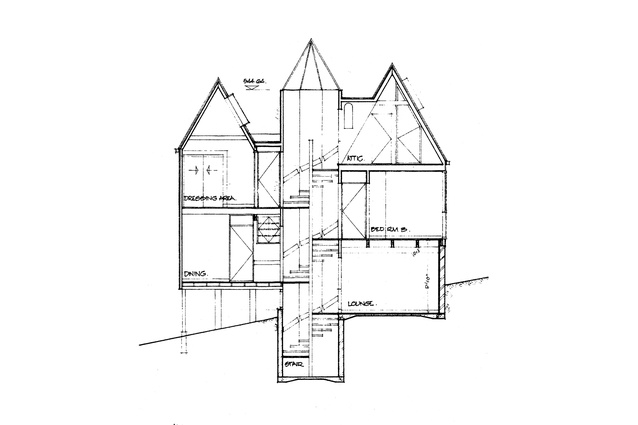Houses Revisited: A second life
The original clients get back a Wellington house designed by the late Chris Brooke-White, one of the great characters of the 1970s, in this project feature from 2008.
In the early 1970s, Ian Drinkwater was a keen parachutist and a quantity surveyor working in the established Wellington architectural firm of Haughton and Mair alongside a promising young architect, Chris Brooke-White. Ian wanted his first house to be a new house, and he wanted it to be architecturally designed. He found a steep west-facing section on the Kelburn/Karori cusp and sold his beloved Fiat 124 Sport Spider to buy it (this was back in the time when a section could be bought for the price of a second-hand car). He paid $3,000 for the section, and his bosses agreed to treat it as an office project.
Ian knew that he wanted Chris Brooke-White to design his house, and the architect agreed to do it. One day in hospital, where he was recuperating after a parachuting accident, Ian asked Chris how the plans were coming along. The answer was inconclusive, but the next day Chris arrived and unfurled a set of plans for a six-level house built around a central staircase. Ian says it’s amazing what one night and a bottle of gin could produce, though perhaps not surprising when the architect doing the producing was Chris Brooke-White.
The late Chris Brooke-White is a legend in Wellington architectural circles. English educated, he was an excellent architect – and also a cartoonist, raconteur and drinker. He excelled at all these things; for those architects who were practising in Wellington in the ’70s and ’80s, Brooke-White epitomised the free spirit of the age. His work was mostly commercial, including that modern masterpiece, the Central Institute of Technology in Heretaunga, and he built few houses.
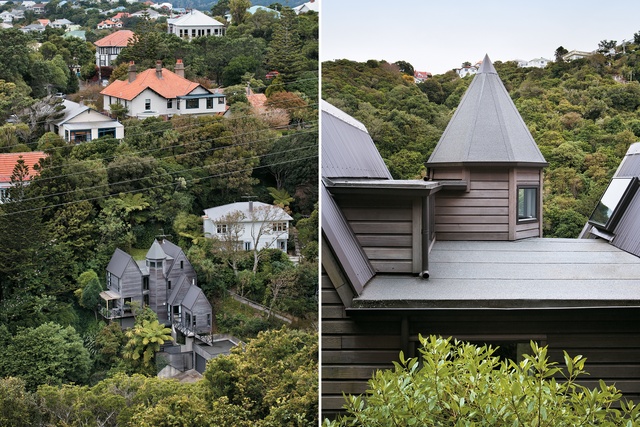
The Drinkwater House in Kelburn is a fine example of the ‘tree house’ architecture of its time; its façade is almost a cartoon. Several slender gabled forms rise up from the road, slightly set back from each other like a house of cards. The layered effect appears flat and obscures what is a very dynamic house built around a central core. Entry is at the lowest level at the base of the stair, which is a circular construction within an octagonal tower.
Laminated pine treads radiate out, supported on steel brackets that slide over a central steel pole. The result is a light tread in a confined space. One floor up is the living area – a main room with a step down to a den. This is a small room, barely 2.5m wide, with a high, gabled roof. On a plan, it might seem simply too small to work but it is surprisingly successful, being at once intimate and liberating. A small deck to the north is scale perfect.
Half a flight up is the dining and kitchen area. Economic in space, the dining room sits to the north where the kitchen nestles into the hill behind. The kitchen has been rebuilt in its existing position, which, despite being at the rear of the house, is a commanding one. Four windows present at least three different views: to the verdant bank behind; to the north up the valley; and to the west to the native bush across the valley. It is remarkable that Brooke-White could have positioned the windows to capture the views in this manner.
Another turn around the stair leads to a small bedroom, the bathroom and the laundry. The latter leads, like the kitchen, to the bank outside. Further up the stair, above the kitchen and dining area, is a pair of double bedrooms. One faces north and west; the other looks to the east and the green of the hills behind. The final turn on what seems an interminable stair leads to an eyrie which could be a bedroom but is currently a studio. From the narrow, steep-ceilinged room, a triangular door opens onto a bridge across to a clearing in the bank.
The house is a remarkable collection of spaces that pivot and rise around a central stair, and are assembled seamlessly in a carefully orchestrated form. This is where Brooke-White departed from the work of his more celebrated contemporaries, Roger Walker and the late Ian Athfield, both of whom expressed the dynamism of their forms. With Brooke-White, the dynamism is on the inside, while the exterior projects a relaxed and careful composition.
Ian and Karen Drinkwater sold the house after a couple of years, moving on to other projects. Nearly thirty years later they saw the house for sale and took a look. It had been a student flat for the previous fifteen years and had not weathered well. The Drinkwaters submitted a tender $100,000 below valuation, got the house back, and have since spent the purchase price again restoring it.
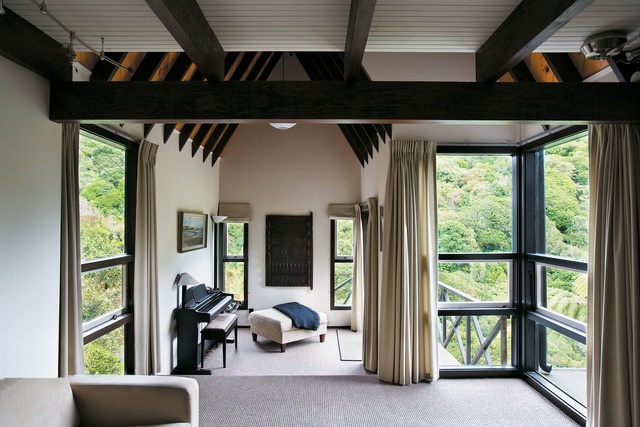
As the original owners, they knew the house intimately and had the sense to update things where they needed to and the sensitivity to leave other things well alone. The Drinkwaters started by stripping the house of its floor coverings (including the original white shagpile carpet) and the original timber beams of paint. The previous owner had done little to maintain the house, and a succession of students had obliterated what character the house had. The elements, too, had not been kind to the exterior of the house. Skylights leaked, and the wind whistled through the draughty house.
The whole house was scaffolded and the existing asbestos super-six rooves were removed and replaced with Colorsteel. The glazed skylight to the top of the staircase, which had always leaked, was replaced with a roof. To compensate for the loss of light, four small windows were added at the top of the tower. The cedar weatherboard cladding was replaced on two sides of the house and the aging quarry tiles on the approaching steps were removed and the area was retiled.
The existing rimu window frames were generally in good condition and they were given new flashings and facings. Skylights were replaced, and gradually the exterior began to assume some of its former glory. Inside, the bathroom and kitchen were refurbished, the floors throughout were sanded, and the shagpile was replaced by new carpet.
This house has been blessed to have its original owners lovingly restore the intent of the architect. Restoration of houses built as recently as the 1970s is rare but it is essential if we are to understand and retain our modern architectural heritage, which is too often overlooked. Ian and Karen Drinkwater love having their first house back, and take great pleasure in the building’s versatility. They hope, too, that Chris Brooke-White would be pleased with their efforts. Somewhere, perhaps, he’s raising a glass to the clients who have brought one of his houses back to life.
Click here to see more Houses Revisited. And sign up to our email newsletters to receive Houses Revisited straight to your inbox.


